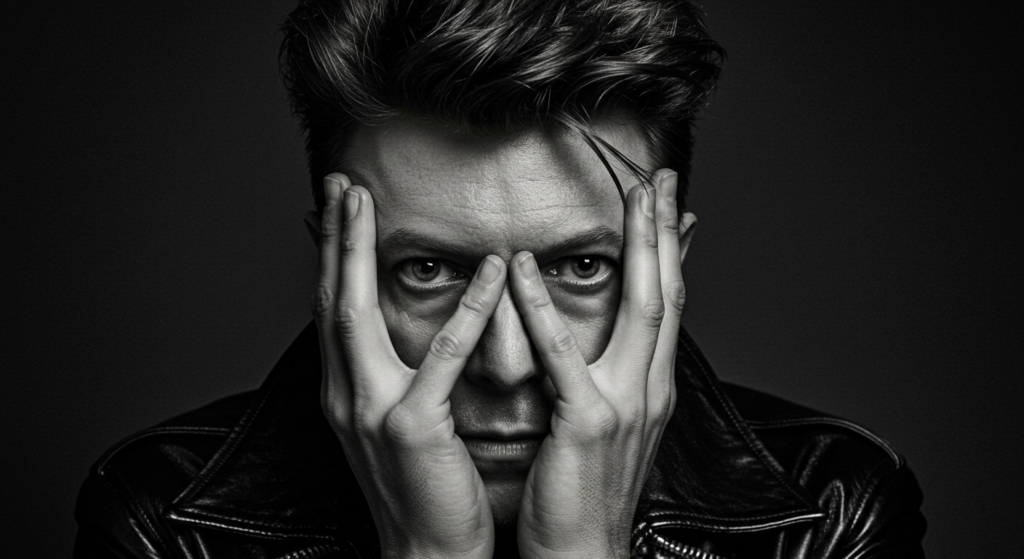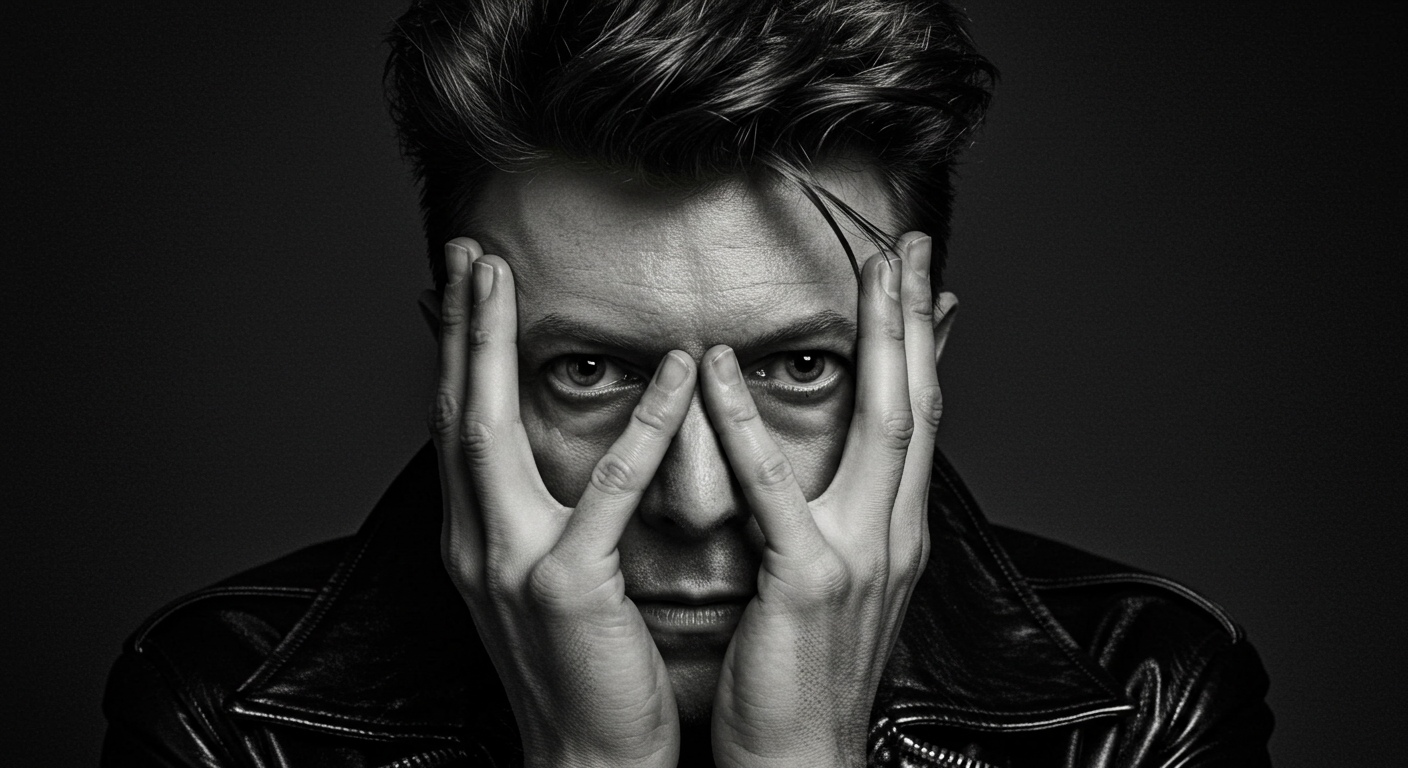写真で英語を探る:デビッド・ボウイのポートレート
Exploring English through Photography: David Bowie’s Portrait
Hello everyone! Today we’re going to improve×意味:
上達させる、改善する。
文法:
- 動詞として使用されます。
- 'improve' は「良くする」という意味です。
例:
I want to improve my English skills.
私は英語のスキルを向上させたいです。
She practiced every day to improve her singing.
彼女は歌を上達させるために毎日練習しました。 our English by describing×意味:
説明する、描写する。
文法:
- 動詞として使用されます。
- 'describe' は「言葉で表現する」という意味です。
例:
Can you describe the picture?
その絵を説明できますか?
He described his hometown in detail.
彼は故郷について詳しく説明しました。 a famous photograph of David Bowie, the legendary×意味:
伝説的な。
文法:
- 形容詞として使用されます。
- 'legendary' は「非常に有名な」という意味です。
例:
He is a legendary singer.
彼は伝説的な歌手です。
The legendary story has been passed down for generations.
その伝説的な物語は何世代にもわたって語り継がれてきました。 British×意味:
イギリスの、英国の。
文法:
- 形容詞として使用されます。
- 'British' は「イギリスに関連する」という意味です。
例:
He is a British actor.
彼はイギリスの俳優です。
British culture is very interesting.
イギリスの文化はとても興味深いです。 musician and artist.

Who was David Bowie? (デビッド・ボウイとは?)
David Bowie was a famous×意味:
有名な。
文法:
- 形容詞として使用されます。
- 'famous'は「多くの人に知られている」という意味。
例:
She is a famous singer.
彼女は有名な歌手です。
That restaurant is famous for its delicious food.
そのレストランはおいしい料理で有名です。 British×意味:
イギリスの、英国の。
文法:
- 形容詞として使用されます。
- 'British' は「イギリスに関連する」という意味です。
例:
He is a British actor.
彼はイギリスの俳優です。
British culture has a long history.
イギリスの文化は長い歴史を持っています。 musician who changed music and fashion. He was known for his unique×意味:
独特の、ユニークな。
文法:
- 形容詞として使用されます。
- 'unique' は「他にない」という意味です。
例:
She has a unique style.
彼女は独特なスタイルを持っています。
This artwork is unique and valuable.
この芸術作品はユニークで価値があります。 style and amazing×意味:
素晴らしい、驚くべき。
文法:
- 形容詞として使用されます。
- 'amazing'は「非常に良い」という意味です。
例:
The view from the mountain was amazing.
山からの景色は素晴らしかったです。
He told us an amazing story.
彼は私たちに驚くべき話をしてくれました。 songs.
Describing the Photograph (写真の描写)
This photograph is in×意味:
この写真は~です。
文法:
- 'This photograph is in...' で「この写真の状態は~である」という意味。
例:
This photograph is in color.
この写真はカラーです。
This photograph is in good condition.
この写真は良い状態です。 black and white, which means it has no colors. Let’s learn how to describe×意味:
説明する、描写する。
文法:
- 動詞として使用されます。
- 'describe'は「詳しく述べる」という意味です。
例:
Please describe what happened.
何が起こったのか説明してください。
The witness described the suspect to the police.
目撃者は警察に容疑者の特徴を説明しました。 different parts×意味:
さまざまな部分。
文法:
- 'different' (異なる) + 'parts' (部分)
- 複数形の名詞
例:
The machine has many different parts.
その機械には多くの異なる部品があります。
We visited different parts of the city.
私たちはその都市のさまざまな場所を訪れました。 of this interesting portrait×意味:
興味深い肖像画。
文法:
- 'interesting' は形容詞で、「面白い」「興味深い」という意味です。
- 'portrait' は名詞で、「肖像画」「ポートレート」という意味です。ここでは写真のポートレートを指します。
例:
This is an interesting portrait of a famous artist.
これは有名な芸術家の興味深い肖像画です。
She painted an interesting portrait of her grandmother.
彼女は祖母の興味深い肖像画を描きました。
写真の内容により、'interesting' の訳語は変わります。文脈から「興味深い」が最適です。!
Face and Expression (顔と表情)
- David Bowie is partially hiding×意味:
部分的に隠している。
文法:
- 'partially' は副詞で、「部分的に」という意味です。
- 'hiding' は動詞 'hide'(隠す)の現在分詞形です。
例:
The moon was partially hidden by clouds.
月は部分的に雲に隠れていました。
He was partially hiding behind the door.
彼は部分的にドアの後ろに隠れていました。 his face with his hands. - His eyes look very intense×意味:
強烈な。
文法:
- 形容詞として使用されます。
- 'intense' は「非常に強い」という意味です。
例:
He has intense blue eyes.
彼は強烈な青い目をしています。
The pain was intense.
痛みは強烈でした。 and wide×意味:
大きく見開いた。
文法:
- 形容詞として使用されます。
- 'wide' は「広い」という意味ですが、ここでは目が大きく開いている状態を表します。
例:
She opened her eyes wide in surprise.
彼女は驚いて目を大きく見開きました。
The child stared at the toy with wide eyes.
子供はおもちゃを大きく見開いた目で見つめました。. - He is peering×意味:
(指の間から)のぞいている。
文法:
- 動詞 'peer' の現在分詞形。
- 'peer'は「じっと見る」「のぞき込む」という意味。
例:
She peered through the window.
彼女は窓からのぞき込んだ。
He peered at the small print.
彼は小さな活字をじっと見た。 between his fingers. - His expression×意味:
表情。
文法:
- 名詞として使用されます。
- 'expression'は「顔の様子」という意味です。
例:
She had a happy expression.
彼女は幸せそうな表情をしていた。
His expression was hard to read.
彼の表情は読み取りにくかった。 looks mysterious×意味:
神秘的な。
文法:
- 形容詞として使用されます。
- 'mysterious' は「謎めいた」という意味です。
例:
She had a mysterious smile.
彼女は神秘的な笑みを浮かべていた。
The package contained a mysterious object.
その小包には謎の物体が入っていた。 and dramatic×意味:
ドラマチックな、劇的な。
文法:
- 形容詞として使用されます。
- 'dramatic' は「大げさな」「印象的な」という意味です。
例:
She made a dramatic entrance.
彼女は劇的な登場をした。
The movie had a dramatic ending.
その映画は劇的な結末を迎えた。.
Hair and Appearance (髪と外見)
- His hair is spiky×意味:
とがった、逆立った。
文法:
- 形容詞として使用されます。
- 'spiky' は「先がとがっている」という意味です。
例:
He has spiky hair.
彼の髪はとがっています。
The cactus has spiky leaves.
そのサボテンはとがった葉を持っています。 and messy×意味:
乱れた、くしゃくしゃの。
文法:
- 形容詞として使用されます。
- 'messy'は「整っていない」という意味です。
例:
My hair is messy after sleeping.
寝起きの髪はぐちゃぐちゃです。
The room was messy.
部屋は散らかっていました。. - The hair is dark×意味:
濃い色の。
文法:
- 形容詞として使用されます。
- ここでの'dark'は「色が濃い」という意味。
例:
She has dark hair.
彼女は濃い色の髪をしています。
He prefers dark chocolate.
彼はダークチョコレートが好きです。 and styled×意味:
スタイリングされた。
文法:
- 動詞'style'(髪型を整える)の過去分詞形。形容詞的に使われています。
例:
Her hair was beautifully styled.
彼女の髪は美しくスタイリングされていました。
He has his hair styled at a salon.
彼はサロンで髪をスタイリングしてもらいます。 upwards×意味:
上向きに。
文法:
- 副詞として使用されます。
- 'upwards' は「上の方へ」という意味です。
例:
The bird flew upwards.
鳥は上に向かって飛んだ。
He looked upwards at the sky.
彼は空を見上げた。. - His hair reaches×意味:
彼の髪は~に達している。
文法:
- 'His hair' (彼の髪) + 'reaches' (届く、達する)
- 動詞 'reach' の三人称単数現在形
例:
His hair reaches his shoulders.
彼の髪は肩まで届いています。
The vine reaches the top of the wall.
そのつるは壁の一番上まで達しています。 ear-length×意味:
耳の長さ。
文法:
- 'ear-length' で「耳までの長さ」という一つの形容詞。
例:
She has ear-length hair.
彼女は耳の長さの髪をしています。
He prefers ear-length hairstyles.
彼は耳の長さのヘアスタイルを好みます。. - He has thick eyebrows×意味:
太いまゆげ。
文法:
- 'thick' (太い、厚い) + 'eyebrows' (眉毛、複数形)
例:
She has thick, dark eyebrows.
彼女は太くて濃いまゆげをしています。
He drew thick eyebrows on the caricature.
彼は似顔絵に太いまゆげを描きました。.
Clothing (服装)
- He wears a black leather×意味:
革の。
文法:
- 形容詞として使用されます。
- 'leather' は「動物の皮から作られた素材」という意味です。
例:
He has a leather jacket.
彼は革のジャケットを着ています。
These shoes are made of leather.
この靴は革でできています。 jacket. - The jacket has visible creases×意味:
目に見えるしわ。
文法:
- 'visible' (目に見える) + 'creases' (しわ、複数形)
例:
There are visible creases on the shirt.
シャツには目に見えるしわがあります。
The old map had visible creases.
古い地図には目に見える折り目がありました。. - There is a metallic×意味:
金属製の。
文法:
- 形容詞として使用されます。
- 'metallic' は「金属のような」という意味です。
例:
The car has a metallic color.
その車はメタリックカラーです。
She wore a metallic dress.
彼女は金属製のドレスを着ていました。 zipper on the jacket. - Under the jacket, you can see a black collar×意味:
襟。
文法:
- 名詞として使用されます。
- 'collar' は「衣服の首回り部分」という意味です。
例:
The shirt has a white collar.
そのシャツは白い襟が付いています。
He turned up his coat collar.
彼はコートの襟を立てました。.
Vocabulary Practice (語彙練習)
Match the English words with their meanings:
- portrait
- leather
- mysterious
- partially
- intense
a. 革
b. 部分的に
c. 肖像画
d. 神秘的な
e. 強烈な
Writing Practice (ライティング練習)
Try to write 3-5 sentences about this photo using some of our new words. Here’s an example:
“This is a black and white portrait of David Bowie. He is hiding part of his face with his hands. His eyes look very intense. He is wearing a black leather jacket.”
Now it’s your turn!
Speaking Activity (スピーキング活動)
With a partner, take turns describing the photo. Use these question prompts:
- What is he wearing?
- How does his hair look?
- What is he doing with his hands?
- How would you describe his eyes?
New Vocabulary List (新しい語彙リスト)
| English | Japanese | Example Sentence |
|---|---|---|
| portrait | 肖像画 | This is a portrait of David Bowie. |
| leather | 革 | The jacket is made of black leather. |
| intense | 強烈な | His eyes look very intense in the photo. |
| mysterious | 神秘的な | He has a mysterious expression. |
| partially | 部分的に | His face is partially hidden by his hands. |
| spiky | とがった | His hair is spiky and messy. |
| peering | じっと見ている | He is peering over his fingers. |
| metallic | 金属の | The jacket has a metallic zipper. |
| visible | 目に見える | There are visible creases in the leather. |
| unique | 独特な | David Bowie had a unique style. |
Challenge Question (チャレンジ問題)
Why do you think photographers sometimes choose to take photos in black and white instead of color? Write 2-3 sentences with your opinion.
Remember: Practice makes perfect! Try using these new words in your daily conversations.







